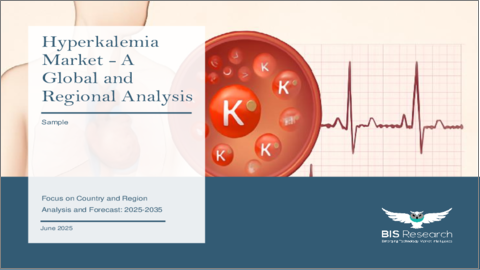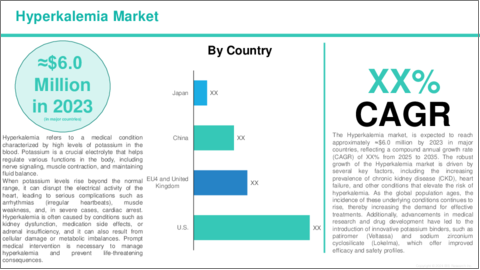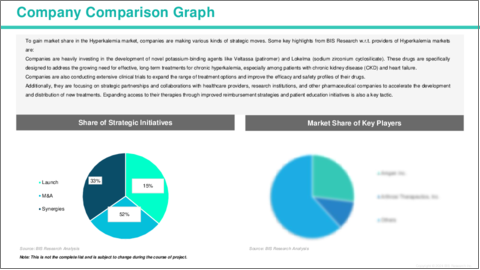|
|
市場調査レポート
商品コード
1759278
高カリウム血症市場- 世界および地域別 - 分析と予測(2025年~2035年)Hyperkalemia Market - A Global and Regional Analysis: Focus on Country and Region - Analysis and Forecast, 2025-2035 |
||||||
カスタマイズ可能
|
|||||||
| 高カリウム血症市場- 世界および地域別 - 分析と予測(2025年~2035年) |
|
出版日: 2025年06月30日
発行: BIS Research
ページ情報: 英文 100 Pages
納期: 1~5営業日
|
- 全表示
- 概要
- 図表
- 目次
高カリウム血症は、血液中のカリウム濃度の上昇を特徴とする病状です。
カリウムは必須電解質であり、神経伝達、筋収縮、体液バランスなど、重要な身体機能の調節に役立っています。しかし、カリウム濃度が高くなりすぎると、深刻な健康問題、特に心臓に影響を及ぼす可能性があります。高カリウム血症は、腎臓が血液から過剰なカリウムをろ過する役割を担っているため、腎機能障害によって引き起こされることがほとんどです。慢性腎臓病(CKD)、心不全、糖尿病などの病態は腎機能を低下させ、高カリウム血症のリスクを高めます。また、RAAS阻害薬(ACE阻害薬、ARB)やカリウム温存利尿薬など、カリウム濃度を上昇させる可能性のある特定の薬剤の使用によっても高カリウム血症になることがあります。高カリウム血症の症状には、筋力低下、疲労、不整脈、重症の場合は心停止などがあります。状態を管理し、生命を脅かす合併症を予防するためには、早急な治療が必要です。
高カリウム血症市場の主要促進要因の一つは、慢性腎臓病(CKD)の有病率の上昇です。世界人口の高齢化に伴い、CKDの罹患率が上昇し、高カリウム血症のリスクが高まる。CKDでは腎機能が徐々に低下し、過剰なカリウムをろ過して体外に排泄する腎臓の機能が損なわれます。その結果、血液中にカリウムが蓄積し、高カリウム血症を引き起こします。さらに、CKD患者はその状態を管理するためにRAAS阻害薬(ACE阻害薬、ARB、アルドステロン拮抗薬など)による治療を受けることが多く、カリウム濃度をさらに上昇させる可能性があります。世界のCKD患者の増加に伴い、高カリウム血症を効果的に管理する治療に対する需要が大幅に増加しており、市場成長の原動力となっています。さらに、高カリウム血症の一因でもある心不全や糖尿病の有病率が上昇していることも、この市場の成長をさらに後押ししています。
高カリウム血症市場の成長にもかかわらず、いくつかの課題がその進展を阻害し続けています。主な課題の1つは、治療費の高さであり、特にVeltassa(パティロマー)やLokelma(シクロケイ酸ジルコニウムナトリウム)のようなカリウム結合剤のような新しい治療法はその傾向が強いです。これらの治療は高額であるため、特に低所得地域やヘルスケア保険が限られている患者にとっては、利用しにくいものとなっています。慢性腎臓病(CKD)や心不全のような慢性疾患に対する継続的な治療費は、ヘルスケアシステムと患者に大きな経済的負担を強いることになり、これらの治療法の全体的な普及率を低下させる。さらに、胃腸不快感(便秘、下痢、腹痛など)など、一部のカリウム低下薬に伴う副作用は、患者のコンプライアンスに影響を与え、治療レジメンの有効性に影響を及ぼす可能性があります。これらの要因は、効果的な解決策に対する需要が高まっているにもかかわらず、高カリウム血症管理戦略の広範な実施における障壁の一因となっています。
世界の高カリウム血症市場は競争が激しく、複数の主要企業が技術革新と市場成長を牽引しています。Sanofi、Ardelyx、AstraZeneca、Vifor Pharma、Eli Lilly and Companyなどの企業は、高カリウム血症の治療法の開発と提供の最前線にいます。特に慢性腎臓病(CKD)や心不全患者における慢性高カリウム血症の治療において、サノフィのVeltassa(パティロマー)は重要な役割を果たしています。アルデリックスは、高カリウム血症治療薬テナパノールで革新的な治療を行っており、アストラゼネカは、急性・慢性両方の高カリウム血症に有効な経口カリウム結合剤ロケルマ(シクロケイ酸ジルコニウムナトリウム)を提供しています。また、Eli Lilly and Companyは、腎臓病や心不全などの関連疾患に対する幅広い治療ポートフォリオで市場に貢献し続けています。これらの企業は、新たな治療法を開発するだけでなく、CKDや心不全の世界の増加、高齢化に伴う高カリウム血症患者の増加による需要増に対応し、治療選択肢へのアクセス拡大に取り組んでいます。
市場セグメンテーション
セグメンテーション1:地域別
- 北米
- 欧州
- アジア太平洋
世界の高カリウム血症市場は、治療・管理戦略を再構築する新たな動向に後押しされ、大きな変革期を迎えています。この変化を促進する重要な動向の一つは、慢性・急性両方の高カリウム血症を管理するためのより効果的で安全なソリューションを提供するVeltassa(パティロマー)やLokelma(シクロケイ酸ジルコニウムナトリウム)などの革新的なカリウム結合療法への注目の高まりです。これらの新しい治療は、特に慢性腎臓病(CKD)、心不全、カリウム値を上昇させるRAAS阻害剤投与中の患者における高カリウム血症の有病率の増加に対処するために考案されたものです。
もう一つの新たな動向は、個別化医療の台頭です。個別化医療とは、特定の病態や遺伝的要因に基づき、個々の患者のニーズに合わせて治療計画を立てることを目的とするものです。このアプローチは治療効果を高め、患者の転帰を改善します。さらに、デジタルヘルスツールや遠隔患者モニタリングが重視されるようになり、ヘルスケアプロバイダーがカリウム値をリアルタイムで追跡できるようになったことで、高カリウム血症の管理が改善され、入院が減少しています。このような動向を背景に、高カリウム血症治療に対する各社の技術革新とアクセシビリティの向上、特に医療需要が高まっている未開拓地域における高カリウム血症治療の普及が進み、市場は継続的な成長を遂げるものと思われます。
当レポートでは、世界の高カリウム血症市場について調査し、市場の概要とともに、地域別の動向、および市場に参入する企業のプロファイルなどを提供しています。
目次
エグゼクティブサマリー
第1章 世界の高カリウム血症市場:業界見通し
- イントロダクション
- 市場動向
- 規制の枠組み
- 疫学分析
- 臨床試験分析
- 市場力学
第2章 世界の高カリウム血症市場(地域別)、2023年~2035年
- 北米
- 欧州
- アジア太平洋
第3章 世界の高カリウム血症市場:競合情勢と企業プロファイル
- 主要戦略と開発
- 合併と買収
- 相乗効果のある活動
- 事業拡大と資金調達
- 製品の発売と承認
- その他の活動
- 企業プロファイル
- Sanofi
- Ardelyx
- AstraZeneca
- Vifor Pharma (Zeria Pharmaceutical)
- Eli Lilly and Company
- Novo Nordisk
- Zynteglo (Bluebird Bio)
- Novartis AG
第4章 調査手法
List of Figures
- Figure: Global Hyperkalemia Market (by Region), $Billion, 2024 and 2035
- Figure: Global Hyperkalemia Market Key Trends, Analysis
List of Tables
- Table: Global Hyperkalemia Market Dynamics, Impact Analysis
- Table: Global Hyperkalemia Market (by Region), $Billion, 2024-2035
Global Hyperkalemia Market, Analysis and Forecast: 2025-2035
Hyperkalemia is a medical condition characterized by elevated levels of potassium in the blood. Potassium is an essential electrolyte that helps regulate important bodily functions, including nerve transmission, muscle contraction, and fluid balance. However, when potassium levels become too high, it can lead to serious health issues, particularly affecting the heart. Hyperkalemia is most caused by kidney dysfunction, as the kidneys are responsible for filtering excess potassium from the blood. Conditions like chronic kidney disease (CKD), heart failure, and diabetes can impair kidney function and increase the risk of hyperkalemia. It can also result from the use of certain medications like RAAS inhibitors (ACE inhibitors, ARBs) or potassium-sparing diuretics, which may elevate potassium levels. Symptoms of hyperkalemia include muscle weakness, fatigue, irregular heartbeats, and in severe cases, cardiac arrest. Immediate treatment is necessary to manage the condition and prevent life-threatening complications.
One of the key drivers of the Hyperkalemia market is the rising prevalence of chronic kidney disease (CKD). As the global population ages, the incidence of CKD increases, which in turn raises the risk of hyperkalemia. CKD leads to a gradual decline in kidney function, impairing the kidneys' ability to filter and excrete excess potassium from the body. This results in an accumulation of potassium in the bloodstream, causing hyperkalemia. Moreover, CKD patients are often treated with RAAS inhibitors (such as ACE inhibitors, ARBs, and aldosterone antagonists) to manage their condition, which can further increase potassium levels. With the growing number of CKD patients worldwide, there is a significant rise in the demand for treatments that effectively manage hyperkalemia, driving market growth. Additionally, the rising prevalence of heart failure and diabetes, conditions that also contribute to hyperkalemia, further supports this market growth.
Despite the growth of the Hyperkalemia market, several challenges continue to hinder its progress. One of the primary challenges is the high cost of treatment, particularly for newer therapies such as potassium binders like Veltassa (patiromer) and Lokelma (sodium zirconium cyclosilicate). These treatments can be expensive, making them less accessible, especially in low-income regions or for patients with limited healthcare coverage. The cost of ongoing treatment for chronic conditions like chronic kidney disease (CKD) and heart failure can place a significant financial burden on healthcare systems and patients, reducing the overall adoption of these therapies. Additionally, the side effects associated with some potassium-lowering medications, such as gastrointestinal discomfort (e.g., constipation, diarrhea, and abdominal pain), can affect patient compliance and impact the effectiveness of treatment regimens. These factors contribute to barriers in the broader implementation of hyperkalemia management strategies, despite the rising demand for effective solutions.
The global Hyperkalemia market is highly competitive, with several leading companies driving innovation and market growth. Companies such as Sanofi, Ardelyx, AstraZeneca, Vifor Pharma, and Eli Lilly and Company are at the forefront of developing and offering treatments for hyperkalemia. Sanofi, with its Veltassa (patiromer), has been a significant player in managing chronic hyperkalemia, especially in patients with chronic kidney disease (CKD) and heart failure. Ardelyx is innovating with its drug Tenapanor, designed to treat hyperkalemia, while AstraZeneca offers Lokelma (sodium zirconium cyclosilicate), an effective oral potassium binder for both acute and chronic hyperkalemia. Vifor Pharma, in partnership with Zeria Pharmaceutical, provides essential therapies for patients with renal diseases, while Eli Lilly and Company continues to contribute to the market with its broad portfolio of treatments for related conditions like kidney disease and heart failure. These companies are not only advancing new therapies but are also working to expand access to treatment options, meeting the increasing demand driven by rising cases of hyperkalemia due to the global increase in CKD, heart failure, and an aging population.
Market Segmentation:
Segmentation 1: by Region
- North America
- Europe
- Asia-Pacific
The global Hyperkalemia market is undergoing significant transformation, fueled by emerging trends that are reshaping the landscape of treatment and management strategies. One of the key trends driving this change is the increased focus on innovative potassium-binding therapies, such as Veltassa (patiromer) and Lokelma (sodium zirconium cyclosilicate), which offer more effective and safer solutions for managing both chronic and acute hyperkalemia. These newer treatments are designed to address the growing prevalence of hyperkalemia, particularly in patients with chronic kidney disease (CKD), heart failure, and those on RAAS inhibitors that increase potassium levels.
Another emerging trend is the rise of personalized medicine, which aims to tailor treatment plans to individual patient needs based on specific conditions and genetic factors. This approach enhances treatment efficacy and improves patient outcomes. Additionally, there is an increased emphasis on digital health tools and remote patient monitoring, allowing healthcare providers to track potassium levels in real-time, thereby improving the management of hyperkalemia and reducing hospitalizations. With these trends, the market is poised for continued growth as companies innovate and improve accessibility to hyperkalemia treatments, particularly in underserved regions with rising healthcare demands.
Table of Contents
Executive Summary
Scope and Definition
Market/Product Definition
Inclusion and Exclusion
Key Questions Answered
Analysis and Forecast Note
1. Global Hyperkalemia Market: Industry Outlook
- 1.1 Introduction
- 1.2 Market Trends
- 1.3 Regulatory Framework
- 1.4 Epidemiology Analysis
- 1.5 Clinical Trial Analysis
- 1.6 Market Dynamics
- 1.6.1 Impact Analysis
- 1.6.2 Market Drivers
- 1.6.3 Market Challenges
- 1.6.4 Market Opportunities
2. Global Hyperkalemia Market (Region), ($Billion), 2023-2035
- 2.1 North America
- 2.1.1 Key Findings
- 2.1.2 Market Dynamics
- 2.1.3 Market Sizing and Forecast
- 2.1.3.1 North America Hyperkalemia Market, by Country
- 2.1.3.1.1 U.S.
- 2.1.3.1 North America Hyperkalemia Market, by Country
- 2.2 Europe
- 2.2.1 Key Findings
- 2.2.2 Market Dynamics
- 2.2.3 Market Sizing and Forecast
- 2.2.3.1 Europe Hyperkalemia Market, by Country
- 2.2.3.1.1 Germany
- 2.2.3.1.2 U.K.
- 2.2.3.1.3 France
- 2.2.3.1.4 Italy
- 2.2.3.1 Europe Hyperkalemia Market, by Country
- 2.3 Asia Pacific
- 2.3.1 Key Findings
- 2.3.2 Market Dynamics
- 2.3.3 Market Sizing and Forecast
- 2.3.3.1 Asia Pacific Hyperkalemia Market, by Country
- 2.3.3.1.1 China
- 2.3.3.1.2 Japan
- 2.3.3.1 Asia Pacific Hyperkalemia Market, by Country
3. Global Hyperkalemia Market: Competitive Landscape and Company Profiles
- 3.1 Key Strategies and Development
- 3.1.1 Mergers and Acquisitions
- 3.1.2 Synergistic Activities
- 3.1.3 Business Expansions and Funding
- 3.1.4 Product Launches and Approvals
- 3.1.5 Other Activities
- 3.2 Company Profiles
- 3.2.1 Sanofi
- 3.2.1.1 Overview
- 3.2.1.2 Top Products / Product Portfolio
- 3.2.1.3 Top Competitors
- 3.2.1.4 Target Customers/End-Users
- 3.2.1.5 Key Personnel
- 3.2.1.6 Analyst View
- 3.2.2 Ardelyx
- 3.2.2.1 Overview
- 3.2.2.2 Top Products / Product Portfolio
- 3.2.2.3 Top Competitors
- 3.2.2.4 Target Customers/End-Users
- 3.2.2.5 Key Personnel
- 3.2.2.6 Analyst View
- 3.2.3 AstraZeneca
- 3.2.3.1 Overview
- 3.2.3.2 Top Products / Product Portfolio
- 3.2.3.3 Top Competitors
- 3.2.3.4 Target Customers/End-Users
- 3.2.3.5 Key Personnel
- 3.2.3.6 Analyst View
- 3.2.4 Vifor Pharma (Zeria Pharmaceutical)
- 3.2.4.1 Overview
- 3.2.4.2 Top Products / Product Portfolio
- 3.2.4.3 Top Competitors
- 3.2.4.4 Target Customers/End-Users
- 3.2.4.5 Key Personnel
- 3.2.4.6 Analyst View
- 3.2.5 Eli Lilly and Company
- 3.2.5.1 Overview
- 3.2.5.2 Top Products / Product Portfolio
- 3.2.5.3 Top Competitors
- 3.2.5.4 Target Customers/End-Users
- 3.2.5.5 Key Personnel
- 3.2.5.6 Analyst View
- 3.2.6 Novo Nordisk
- 3.2.6.1 Overview
- 3.2.6.2 Top Products / Product Portfolio
- 3.2.6.3 Top Competitors
- 3.2.6.4 Target Customers/End-Users
- 3.2.6.5 Key Personnel
- 3.2.7 Zynteglo (Bluebird Bio)
- 3.2.7.1 Overview
- 3.2.7.2 Top Products / Product Portfolio
- 3.2.7.3 Top Competitors
- 3.2.7.4 Target Customers/End-Users
- 3.2.7.5 Key Personnel
- 3.2.7.6 Analyst View
- 3.2.8 Novartis AG
- 3.2.8.1 Overview
- 3.2.8.2 Top Products / Product Portfolio
- 3.2.8.3 Top Competitors
- 3.2.8.4 Target Customers/End-Users
- 3.2.8.5 Key Personnel
- 3.2.8.6 Analyst View
- 3.2.1 Sanofi






